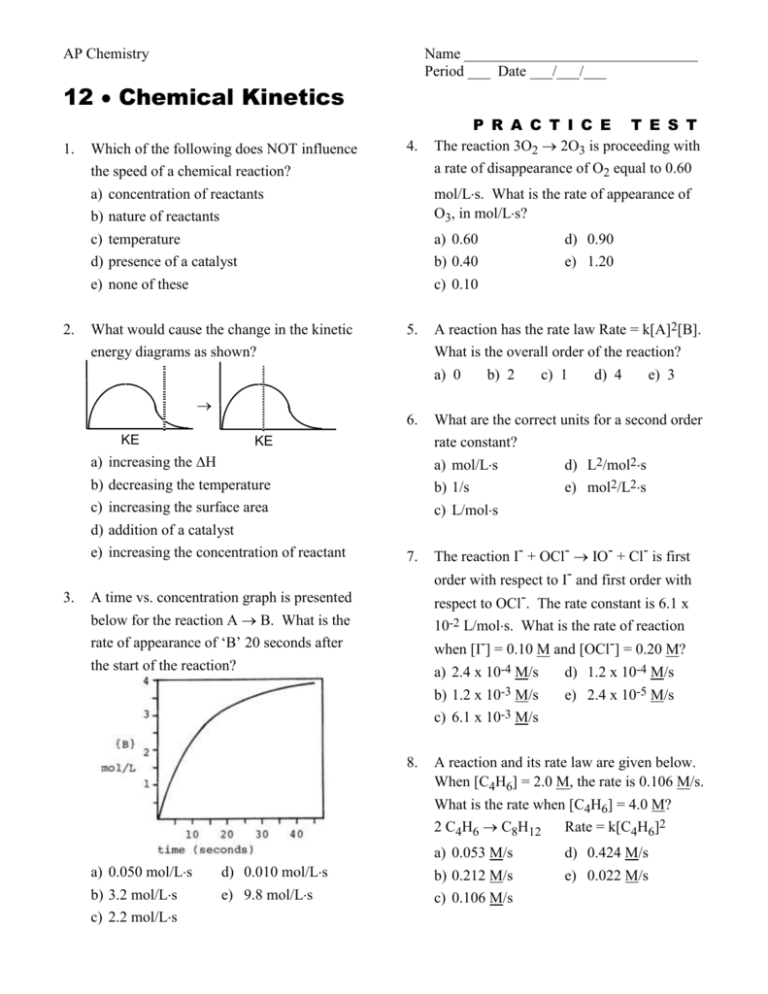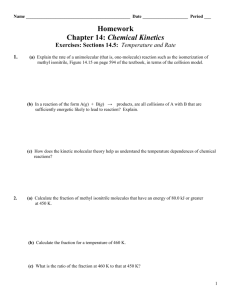South Pasadena · AP Chemistry
advertisement

AP Chemistry Name _______________________________ Period ___ Date ___/___/___ 12 Chemical Kinetics 1. 2. P R A C T I C E T E S T The reaction 3O2 2O3 is proceeding with a rate of disappearance of O2 equal to 0.60 Which of the following does NOT influence the speed of a chemical reaction? a) concentration of reactants b) nature of reactants c) temperature d) presence of a catalyst e) none of these 4. What would cause the change in the kinetic energy diagrams as shown? 5. A reaction has the rate law Rate = k[A]2[B]. What is the overall order of the reaction? a) 0 b) 2 c) 1 d) 4 e) 3 6. What are the correct units for a second order rate constant? a) mol/Ls d) L2/mol2s b) 1/s e) mol2/L2s c) L/mols 7. The reaction I- + OCl- IO- + Cl- is first order with respect to I- and first order with mol/Ls. What is the rate of appearance of O3, in mol/Ls? a) 0.60 b) 0.40 c) 0.10 d) 0.90 e) 1.20 KE KE a) increasing the H b) decreasing the temperature c) increasing the surface area d) addition of a catalyst e) increasing the concentration of reactant 3. respect to OCl-. The rate constant is 6.1 x 10-2 L/mols. What is the rate of reaction when [I-] = 0.10 M and [OCl-] = 0.20 M? A time vs. concentration graph is presented below for the reaction A B. What is the rate of appearance of ‘B’ 20 seconds after the start of the reaction? a) 2.4 x 10-4 M/s b) 1.2 x 10-3 M/s c) 6.1 x 10-3 M/s 8. a) 0.050 mol/Ls b) 3.2 mol/Ls c) 2.2 mol/Ls d) 0.010 mol/Ls e) 9.8 mol/Ls d) 1.2 x 10-4 M/s e) 2.4 x 10-5 M/s A reaction and its rate law are given below. When [C4H6] = 2.0 M, the rate is 0.106 M/s. What is the rate when [C4H6] = 4.0 M? 2 C4H6 C8H12 Rate = k[C4H6]2 a) 0.053 M/s b) 0.212 M/s c) 0.106 M/s d) 0.424 M/s e) 0.022 M/s 9. The rate law for the reaction 2NO(g) + O2(g) 2NO2(g) is Rate = k[NO]2[O2]. What happens to the rate when the concentration of NO is doubled? a) the rate doubles d) the rate is halved b) the rate triples e) none of these c) the rate quadruples 10. Below is some rate data for the hypothetical reaction, 2A + B C. What is the rate law for this reaction? Experiment 1 2 3 [A]o 2.0 M 2.0 M 4.0 M [B]o 1.0 M 2.0 M 1.0 M Rate (M/s) 0.100 0.400 0.100 a) Rate = k[A][B] d) Rate = k[A]2[B]2 b) Rate = k[A]2[B] e) Rate = k[B]2 c) Rate = k[A][B]2 11. The acid catalyzed decomposition of hydrogen peroxide is a first order reaction with the rate constant given below. For an experiment in which the starting concentration of hydrogen peroxide is 0.110 M, what is the concentration of H2O2 450 minutes after the reaction begins? 2H2O2 2H2O + O2 k=1.33 x 10-4 min-1 a) 0.0961 M b) 0.104 M c) 0.117 M d) 0.00658 M e) 0.0156 M 13. What fraction of a reactant remains after 3 half-lives of a first order reaction? a) 1/2 b) 1/3 c) 1/6 d) 1/8 e) 1/12 14. Assume a reaction occurs by the mechanism given below. What is the rate law for the reaction? A+BC fast CD slow a) Rate = k[A][B][C] b) c) d) e) Rate = k[A]2 Rate = k[A][B] Rate = k[A][B]/[D] Rate = k[A] 15. According to collision theory, which of the following factors does NOT influence the rate of reaction? a) collision frequency b) c) d) e) collision energy collision orientation collision rebound direction none of these 16. What distance corresponds to the activation energy for the reaction of X to Y? 12. What is the rate constant for a first order reaction for which the half-life is 85.0 sec? a) 0.00814 sec-1 d) 0.0118 sec-1 b) 4.44 sec-1 e) 58.9 sec-1 c) 0.170 sec-1 a) a b) b c) c d) d e) e 17. At what point on the potential energy diagram given below does the transition state (activated complex) occur? a) a d) d b) b c) c e) e 18. The rate constants, at two different temperatures, for the reaction CH I + Br- CH Br + I3 are given below. t = 30C t = 49C 3 k = 1.38 x 10-4 M-1s-1 k = 1.21 x 10-3 M-1s-1 What is the activation energy for this reaction? R = 8.314 J/molK. a) 92.7 kJ/mol d) 343 kJ/mol b) 200 kJ/mol e) none of these c) 40.3 kJ/mol 19. Which of the following is NOT true about a catalyst? a) it speeds up the forward reaction b) c) d) e) is acts as an inhibitor it speeds up the reverse reaction it may be homogeneous it may be heterogeneous 20. A free radical is a chemical species that possesses a) b) c) d) e) a positive charge a negative charge an unpaired electron an oxygen atom unconventional political views Answers: 1. e 2. d 3. a 4. b 5. e 6. c 7. b 8. d 9. c 10. e 11. b 12. a 13. d 14. c 15. d 16. b 17. c 18. j 19. b (an inhibitor slows a rxn down) 20. c







